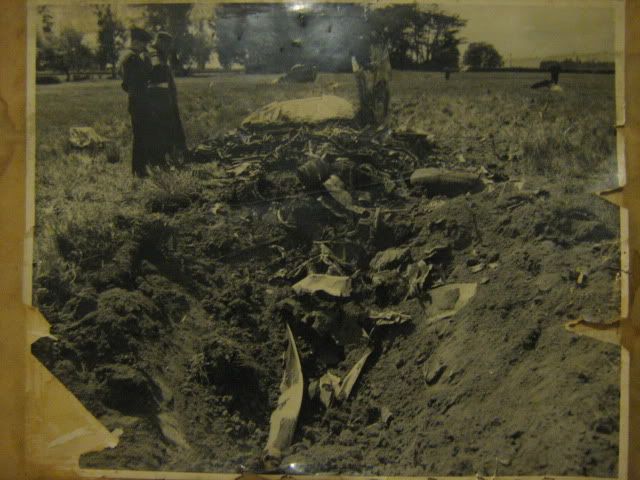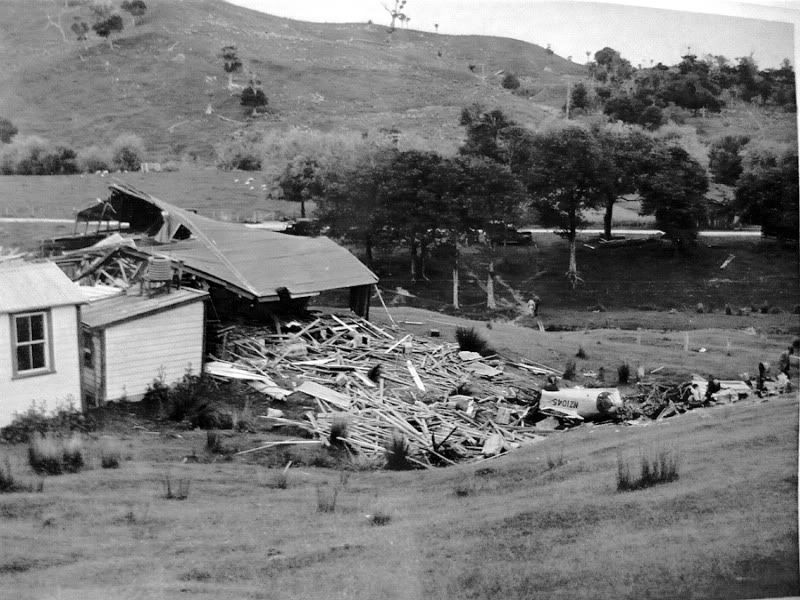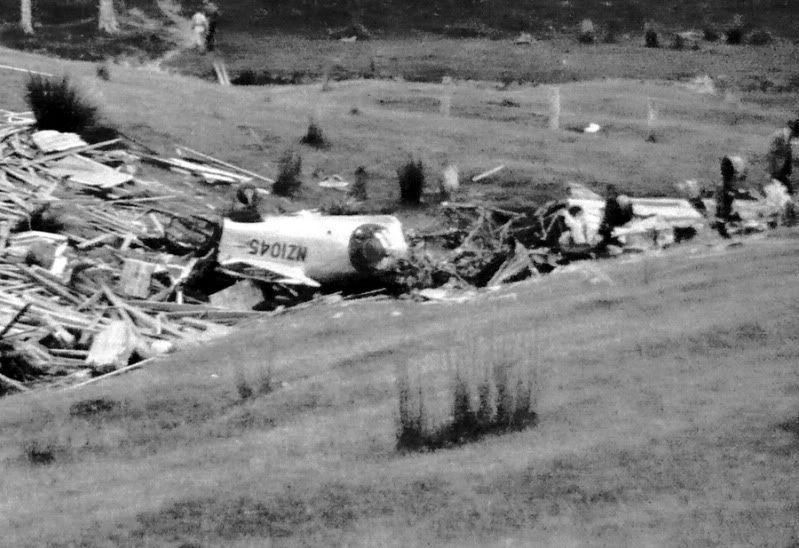|
|
Post by Dave Homewood on May 25, 2010 15:39:19 GMT 12
Thanks Nev. My mistake.
|
|
|
|
Post by shorty on May 27, 2010 20:20:17 GMT 12
Here is another one from the list of missing photos. This is NZ 1081 at Lincoln College (Now Lincoln University) on 17-10-55 The TAF pilot was a Lincoln student.  |
|
|
|
Post by NZ1009 on May 27, 2010 21:46:03 GMT 12
Thanks for that Shorty - must say I would not have recognised it as a Harvard! The entry in For Your Tomorrow for NZ1081 states:
Solo training in the local flying area - NA Harvard III NZ1081 - took off at 1055 with instructions to proced to Lake Ellesmere, where a break in the 7/8-8/8ths cloud was reported to exist. Observed eight minutes later breaking through the 1500-foot cloud base in a steep dive under full power over Springston, 8km SW of the airfield. Pieces of the port wing broke away as it appeared, the dive continuimg until NZ1081 hit the ground. It was thought that the pilot, with no instrument experience, had lost control when attempting to climb through the cloud instead of proceeding to Ellesmere via the reported break. - Acting Pilot Officer Walter Bruce Thomson, RNZAF - Age 18, 9 hours solo (8 on Harvard).
Maybe it is just me but I wonder about the logic of sending such a low houred (and young) pilot off in such conditions, where a break was only reported to exist (presumably at some earlier time) and the Port Hills being reasonably close to the path of the aircraft.
|
|
|
|
Post by Dave Homewood on May 27, 2010 21:58:44 GMT 12
That is grim. It reminded me of this photo which I bought a print of from TradeMe last year, whilst trying to secure the other print that came with it. It shows NZ1045 of No. 30 Squadron, RNZAF Station Gisborne, which struck trees while flying low, hit the house and then the ground. Flying Officer Roland Browne was killed I'm afraid, and his passenger F/O D. Nilsson was badly injured.  It is a gruesome sight, but I find the colour scheme on it really interesting. It appears to be silver with low-viz red-blue roundels. I have seen No. 30 Squadron Harvards in camouflage before but none like this.  The photo is Official (so Air Force Museum of New Zealand, RNZAF Station Gisborne negative number 4570) and dated the 15th of November 1943. |
|
|
|
Post by shorty on May 28, 2010 9:11:54 GMT 12
Dave, your photo was used as a full page shot in a RNZAF Flight Safety mag in the 70s.
|
|
|
|
Post by Dave Homewood on May 28, 2010 9:16:45 GMT 12
It amazes me how much timber has come from the building. I wonder if there was milled timber stored in there as it looks far too much to be from the roof alone.
|
|
|
|
Post by John L on May 28, 2010 15:11:55 GMT 12
It looks like the structure of most of the house........
|
|
|
|
Post by turboNZ on May 31, 2010 13:17:41 GMT 12
This awesome thread of the "Half-Hards" has inspired me to make an alloy clock of one. Would a side one or a frontal one be best? I figured if I make a front-on one, I could make movable landing gear too.  Here's an example of a Tiger I did which I subsequently painted trainer-yellow. Attachments:
|
|
|
|
Post by baz62 on May 31, 2010 15:06:23 GMT 12
NZ1045 might actually be in a bare metal scheme Dave. I recall seeing a picture of NZ1040 in this scheme as at one stage we considered restoring her like this, However we decided to go with the 50's painted silver with yellow bands (which didn't happen and she now flies in Aussie!!)
|
|
|
|
Post by NZ1009 on May 31, 2010 17:22:46 GMT 12
This awesome thread of the "Half-Hards" has inspired me to make an alloy clock of one. Would a side one or a frontal one be best? I figured if I make a front-on one, I could make movable landing gear too.  Here's an example of a Tiger I did which I subsequently painted trainer-yellow. Side on I reckon - and if it is 1009 then you have a potential customer. On a related note, as my modelling skills are non-existent, anyone here interested in building a model of 1009 in the yellow band late 1950s scheme? If so, PM me so we can discuss cost etc. |
|
|
|
Post by lumpy on May 31, 2010 17:42:59 GMT 12
It amazes me how much timber has come from the building. I wonder if there was milled timber stored in there as it looks far too much to be from the roof alone. I think you have to remember that old houses were timber everything , floors , framing , weather boards , internal wall linings ( no gib board in those days ) , ceilings ( you didnt have to watch where you steped , because you couldnt fall through the ceiling if you tried ) . I think some even had full timber roofs , just covered with whatever was desired as weather protection - such as galvanised iron .They dont make them like that anymore ( thankfully ) :-) |
|
|
|
Post by Dave Homewood on May 31, 2010 18:06:35 GMT 12
You're probably right Grant. The wing on the side closest to the camera - not sure which as the fuse is upside down but not sure how it was oriented on impact - has come all the way through the building as can be seen from the path it has left, and from the wingtip which can be seen sticking out of the building. Therefore it's probable the internal structure of the building was brought it with the momentum.
Also, out of interest, looking closely at the print I note there are two RNZAF trucks parked on the road in the background and a couple of airmen standing in the paddock between the crash site and the road. The centre section also looks like it may have burned, as you can see all the internal airframe structure but there's no skin there. How anyone got out of this alive is a miracle.
|
|
|
|
Post by camtech on Jun 2, 2010 9:48:48 GMT 12
Checking on the accident to NZ1045, and referring to "For Your Tomorrow", the accident actually happened on 11 November 1943. The pilot was killed, but his passenger, badly injured and unconcious was dragged from the burning wreckage by the property owner, Mr M L Holden. Mr Holden later was awarded the George Medal and the Royal Humane Society's Silver Medal for his efforts to rescue the crew. I believe there is a book based on his experiences and after effects.
|
|
|
|
Post by NZ1009 on Jun 2, 2010 10:22:04 GMT 12
According to ADFSerials (entry below), 1045 had less than 5 months between BOC and crashing - guess they did not even have time enough to change the paint scheme to camouflage for 30 Sqn. This is also probably the only photo we will ever see of 1045!
"Previously EX748. From RAF/FAA lend-lease allocations. Shipped to New Zealand on "James Hogg" in June 1943 and assembled at Hobsonville. BOC 19 June 1943. To 30 Squadron Gisborne. Crashed and burned during training flight 11 November 1943. The aircraft hit trees on a farm near Gisborne while low flying, lost a wing and crashed through a house before catching fire. Flying Officer Roland Browne killed and Flying Officer D. Nilsson badly burned but survived. Written off books at Gisborne 24 November 1943 as reduced to spares."
The record for the shortest time for a Harvard being BOC to being written off appears to belong to 951 and stands at 24 days. From ADFSerials:
NZ951 66-2764 Mk II ? Issued to NZ under Empire Air Training Scheme. Shipped to New Zealand on "Waiotapu" in May 1941 and assembled at Hobsonville. BOC 05 July 1941. To No.2 SFTS Woodbourne. Crashed near Blenheim during training flight at 1430 hours on 29 July 1941. The aircraft recovered from a dive at 7000 feet and then lost height until crashing into the ground. LAC Morris Jurgens killed.
|
|
|
|
Post by shorty on Jun 2, 2010 15:51:25 GMT 12
"Maybe it is just me but I wonder about the logic of sending such a low houred (and young) pilot off in such conditions"
These days he would be in a Subaru Impressa doing burn outs down Bealey Ave.
|
|
|
|
Post by baz62 on Jun 2, 2010 19:53:33 GMT 12
"Maybe it is just me but I wonder about the logic of sending such a low houred (and young) pilot off in such conditions" These days he would be in a Subaru Impressa doing burn outs down Bealey Ave. Ha ha thats funny Shorty! And I'd say wartime conditions and a pressing need for aircrew they probably had a short time frame for training. And as to the conditions they probably thought he would turn back if things got dicey. I mean even today you get to do so many hours and once you are deemed proficient its off to the next phase of training. If not you are chopped! Unlike civil training (like a PPL) where you take as long as you like until you get it right!! Personally it took me about 14 or 15 hours before I went solo during my PPL training. Some of that was caused by weather keeping me on the ground and only flying once a week but I'd say I was only an average student whereas some of my fellow students managed it in half the time. (Show offs!! ;D) |
|
|
|
Post by NZ1009 on Jun 2, 2010 20:41:04 GMT 12
1081 crashed on 17-10-55 - well after the war.
|
|
|
|
Post by trx850 on Jun 22, 2010 22:36:45 GMT 12
Here's another oddity to add to the Harvard pile! I've not seen this scheme before!  Cheers, Pete M. P.s. Lots more Harvards to come soon!!!!!! |
|
|
|
Post by Dave Homewood on Jun 22, 2010 22:53:05 GMT 12
|
|
|
|
Post by trx850 on Jun 23, 2010 14:39:55 GMT 12
Trust me not to re-check all the postings Dave! The photos came via Anthony. Cheers, Pete M.  |
|



